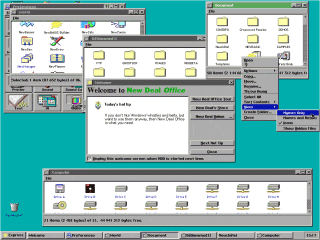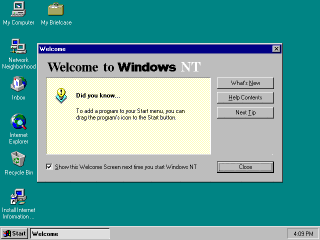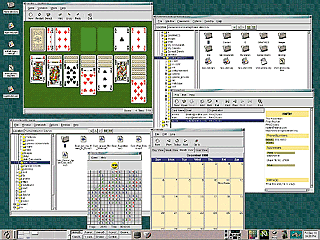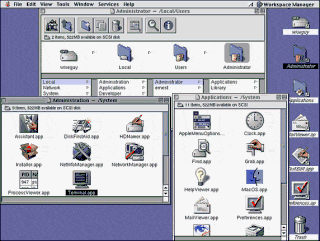 GUIs GUIs
 Site News Site News
 Xerox Xerox
 Visi On Visi On
 GEM GEM
 Deskmate Deskmate
 GEOS GEOS
 Desqview/X Desqview/X
 AmigaOS AmigaOS
 RISC OS RISC OS
 BeOS BeOS
 QNX QNX
 OS/2 OS/2
 Apple Apple
 Linux/Unix Linux/Unix
 Windows Windows
 Win Shells Win Shells
 Misc GUIs Misc GUIs
 GUI Timeline GUI Timeline
 GUI Sites GUI Sites

|
Location: GUIs >
Graphical User Interface Timeline
<< Previous Page | 1 | 2 | 3 | 4 | Next Page >>
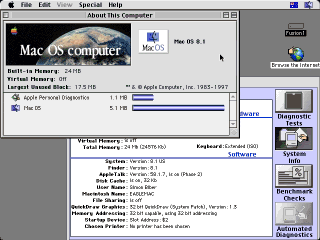 |
July 1997: Mac OS 8 is finally released. Selling
1.25 million copies in less than 2 weeks, it becomes the best-selling software
in that period.
More Info... Links... |
 |
June 25, 1998: Microsoft releases Windows 98.
Features: Internet Explorer Web browser application takes over the role
of the Windows shell, advertising right on the desktop, entire help system
replaced by Internet Explorer.
More Info... Links...
|
 |
July 12, 1998: KDE 1.0 released
Features: A very Windows 9x like environment for Linux.
More Info... Links.... |
 |
November 22, 1998: Shane Brooks Releases 98Lite, an installer
that removes or prevents the installation of Internet Explorer with Windows
98.
Features No Internet Explorer or advertising, all the hardware support
of Windows 98, faster boot time, and the more responsive Windows 95 shell.
More Info... Links... |
 |
January 5, 2000: Apple announces Aqua,
the new look for their upcoming MacOS X client.
More Info... Links.... |
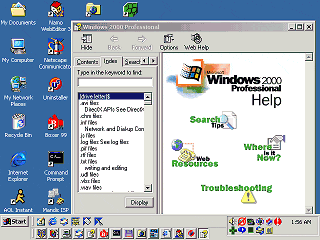 |
February 17, 2000: Microsoft Windows 2000 (AKA Windows NT 5) becomes
available in stores.
Features: The Internet Explorer web browser application finally takes
over the Windows NT UI.
More Info... Links...
|
 |
October 25, 2001: Microsoft releases
Windows XP (AKA Windows NT 5.1)
Features:
Tons of eye candy.
"Product Activation" tethers XP to the existence of the Microsoft corporation.
The dog from Microsoft Bob.
More Info... Links...
|
 |
April 24, 2003: Microsoft releases Windows
Server 2003 (AKA Windows NT 5.2 and for a time called "Windows.NET server")
Features:
Drops the eye candy.
Server-only release.
More Info... Links...
|
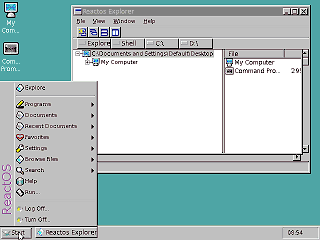 |
January 2004, ReactOS 0.2.0 is released. ReactOS
is a 32-bit Windows clone and can even use Windows NT device drivers. This
is the first version to include its GUI shell - ReactOS Explorer. At this
point ReactOS is still in early development and can only run very simple
Windows applications such as Solitaire.
More Info... Links....
|
 |
January 30, 2007. After a long wait, Microsoft
finally releases Windows Vista (Windows NT 6.0).
Features:
3D hardware-rendered user interface like MacOS X.
Bundles IE 7,. unremovable as always.
Increased Digital Restrictions Management that tries to prevent playback
or duplication of unlicensed audio and video material.
The very next day Mooninites
invade Boston, creating terror, bringing the city to a standstill, and
costing millions of dollars in damage. Coincidence? I don't think
so.
More Info... Links.... |
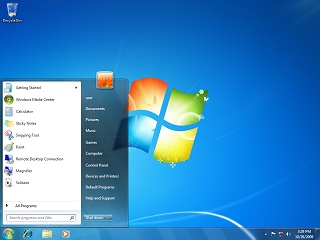 |
July 2009. Windows 7 (NT 6.1) released
- relatively little difference over Vista, but may be historically important
as the last vaguely sane version of Windows.
Features:
You can "pin" icons to the Taskbar.
Ribbons replace menus in some applications.
More Info... Links.... |
 |
April 2011. Ubuntu releases 11.4 with it's
new Unity interface.
Features:
Removes the task bar.
Launcher merges the role of the taskbar and the top panel's shortcuts.
The Top Bar displays the menu of the current foreground application
like the MacOS menu bar.
The Home Button and the "Dash" replace the Applications Menu.
More Info... Links.... |
 |
April 2011. Gnome 3 released, with a desktop that is similar
to that of Unity.
Features:
Removes most of the cutomizability of Gnome 2.
More huge icons that take up the entire screen.
More Info... Links.... |
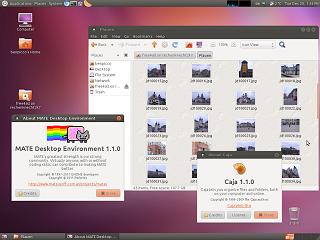 |
August 19, 2011: MATE released. MATE is a fork of the GNOME
2 desktop that preserves the same user interface.
Features:
A standard desktop user interface
All the flexibility and configurability of GNOME 2.x
More Info... Links....
|
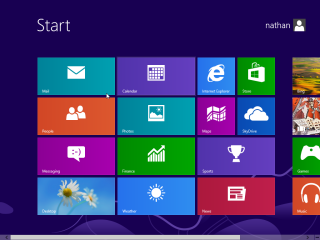 |
August 2012. Microsoft releases Windows 8 (NT
6.2), placing a minimalist interface optimized for mobile devices over
its Vista/7 desktop interface.
Features:
"Apps" that you can only use if you have a Microsoft Live internet
account.
These "apps" all run in a full screen DOS like mode ironically called
"Modern UI" (formerly called Metro prior to release.)
Heavily promotes impractical "touch" navigation of the UI on desktop
systems.
Mouse navigation uses invisible non-discoverable actions involving
the corners of the screen.
Removes the "Start" menu from the desktop mode.
Other changes leave the desktop a confusing mix of UIs.
Windows 8 logo compliant computers require "SecureBoot" which creates
a barrier to running any non Microsoft signed OSes.
More Info... Links.... |
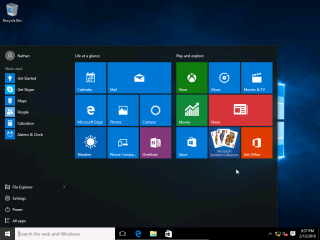 |
July 2015. Microsoft releases Windows 10, mostly
reverting back to a traditional desktop, and "Metro" app windows now overlap.
The Start menu includes the contents of the Windows 8 Start Screen.
Microsoft uses Windows 10 for advertising and bundles "telemetry" spyware.
To get people to switch, they offer all Windows 7 and 8 users a free
"upgrade" to Windows 10.
More Info... Links.... |
Notes:
I am limiting this timeline to systems that provide GUI services to
other applications, this is why I am not including individual graphical
DOS applications or older graphical programs such as Sketchpad.
I am also not listing each version of a GUI system unless a significant
change has occurred in it. MacOS has kept the same basic user interface
since Version 1 and is therefore only mentioned a couple of times. Microsoft,
on the other hand thinks it is fun to make users learn a completely new
interface every few years, so each of the Windows interfaces is listed.
(Except for Windows ME which looked just like Windows 98 and 2000).
Issues:
X could just about have its own history page. There is no way I can
list all of the different appearances of X here so I am just mentioning
its creation. The picture is much more recent and not of the original X.
The picture of NextStep is of a later version.
The picture of BeOS is from a later version.
The color Mac screen shot is of MacOS 7.5.5, although these machines
shipped with earlier versions.
The Desqview/X screenshot is of a later version.
I have insufficient information about the history of the Apollo workstation
to place it on this timeline.
<< Previous Page | 1 | 2 | 3 | 4 | Next Page >>
|
